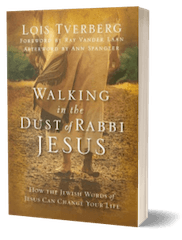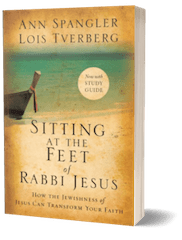 Some time back ago, pastor/blogger Trevin Wax posted an article called “Urban Legends: The Preacher’s Edition.”
Some time back ago, pastor/blogger Trevin Wax posted an article called “Urban Legends: The Preacher’s Edition.”
There he lists several “urban legends” that he’s heard floating around lately in sermons. Like Internet rumors that people forward on ad infinitum, these preaching illustrations don’t have much grounding in fact.
One potential fallacy on his list caught my eye. It’s the saying, “be covered in your rabbi’s dust.” Trevin writes:
“This is one of the most pervasive and fast-spreading stories to flood the church in recent years. The idea is that as you walked behind your rabbi, he would kick up dust and you would become caked in it and so following your rabbi closely came to symbolize your commitment and zeal.”
I heartily agree with Trevin’s much-needed reminder to double-check your facts. But I’ve written about this idea about “dust” myself. If you haven’t heard it from me, you may have heard a sermon about “getting dusty” from preachers like John Ortberg, Ed Dobson or Rob Bell, or watched Ray Vander Laan’s DVD, In the Dust of the Rabbi. (1)
It seems reasonable, then, to explore the historical background of being “covered in dust.” Is it just a faddish fairytale? Let’s take a closer look.
Powdering Yourself in Dust
The source of this saying is the Mishnah, Avot 1:4. (The Mishnah is a collection of rabbinic thought from 200 BC to 200 AD that still forms the core of Jewish belief today.) The quotation is from Yose ben Yoezer (yo-EHZ-er). He was one of the earliest members of the rabbinic movement, who lived about two centuries before Jesus:
Let thy house be a meeting-house for the wise;
and powder thyself in the dust of their feet;
and drink their words with thirstiness. (2)
The overall idea here is to encourage people to make their homes places of Bible study, and to welcome itinerant teachers and eagerly learn from them. These teachers were called “sages” before 70 AD (hakamim, or “the wise”). After that the title “rabbi” began to be used. (3)
The middle line is sometimes translated as “sit amid the dust of their feet,” and understood as being about humbly sitting at the feet of one’s teacher to learn from him. This is because it was customary to honor a teacher by sitting on the floor while he taught seated in a chair.
From this arose a widely-used idiom for studying with a rabbinic teacher, that you “sat at his feet.” Paul even says that he was educated “at the feet of Gamaliel” (Acts 22:3). The fact that Mary “sat at Jesus’ feet” in Luke 10:39 suggests that she was learning from him as a disciple, too. (4)
If you look more closely at the Hebrew text of Avot 1:4, however, it does not explicitly describe a person as sitting. It reads, hevei mitabek b’afar raglehem—literally, “and be powdering yourself with the dust of their feet.”
 The verb mitabek is the hitpael form of avak, and it means “to powder yourself,” like a woman powdering her face. It comes from the noun avak, which is very fine powder, often that which is kicked up by feet on a dusty road. (See Ezekiel 26:10, Nahum 1:3; Mishnah Shabbat 3:3, 12:15).
The verb mitabek is the hitpael form of avak, and it means “to powder yourself,” like a woman powdering her face. It comes from the noun avak, which is very fine powder, often that which is kicked up by feet on a dusty road. (See Ezekiel 26:10, Nahum 1:3; Mishnah Shabbat 3:3, 12:15).
Read literally, Yoezer’s saying sounds more like it’s describing the idea of “powdering yourself” by walking through clouds of dust billowing up along a dirt roadway. Because of this, some highly respected scholars believe that “walking in your teacher’s dust” was the original intent of Avot 1:4. (5)
Supporting this conclusion, rabbinic literature records numerous discussions between rabbis and disciples as they traveled from town to town. The teacher always walked in front, and his students behind. Here’s how one scene begins (~120 AD):
“Once Rabbi Ishmael, Rabbi Eleazar and Rabbi Akiva were walking along the road followed by Levi the net-maker and Ishmael the son of Rabbi Eleazar. The following question was discussed by them: ‘Whence do we know that the duty of saving a life supersedes the Sabbath laws?’”(6)
Apparently, three scholars decided to confer on an issue as they journeyed together, while two of their disciples followed closely behind, taking mental notes.
In earlier periods, discussions between sages and their disciples are often set within daily life—while sitting under a tree, in a marketplace, sharing a meal, or walking along a road. It was about a century after Christ that rabbinic study became confined to study halls and synagogues. (7) The Gospel accounts firmly fit Jesus into the earlier tradition of training disciples through living and traveling together.
Walking or Sitting?
So, how should we read Yoezer’s adage? Is it about sitting or about walking? Both readings are possible. The first line of Avot 1:4, about “making your home a meeting place” suggests that it’s about inviting him in and sitting at his feet. The second two lines suggest traveling behind him—not only does a disciple get dusty journeying behind his teacher, he gets thirsty too.
Modern commentaries realize that Avot 1:4 has more than one possible interpretation, so many mention both. The well-known Soncino Talmud, for instance, states:
Either: let the dust of the feet of the Sages, as they walk, cover you (i.e., follow them closely), or, sit in the dust (on the ground) at their feet whilst they teach. (8)
In The Moral Maxims of the Sages of Israel: Pirkei Avot, Martin Sicker writes,
What is the sage attempting to convey by his urging that one “become covered with the dust of their feet”? Some consider this to reflect the imagery of a group of disciples sitting on the earth at the feet of their master, who is seated on a stool before them. … Others, however, see it as urging the disciple to follow in the footsteps of his master wherever he goes, figuratively as well as literally. In either case, the teaching may be understood to convey the idea that the disciple should always remain within the ambit of his master’s “dust” or influence. (9)
That’s why I usually quote this line as about “being covered” in the dust of your rabbi, which can suggest either walking or sitting. The point of course, is to humbly follow in Christ’s footsteps, staying close beside him and drinking in his words.
~~~~~
(I originally posted this article in January 2012 to respond to the blog by Trevin Wax on April 27, 2011. In the comment section of Wax’s blog post, I shared my response to him with a link to this article and other commenters noted it too. Wax’s article has now been moved to a new site and the discussion has been deleted. I would point out that the fact that Wax never updated his blog after being notified that “dust” is not an urban legend makes him guilty of publishing untruths, the very thing that he was denouncing.)
(1) Ray Vander Laan is the author of the Faith Lessons DVD series, which is based on his years of leading study trips to Israel, Greece and Turkey. Ray was actually the first to preach widely about the idea of “becoming dusty” as a disciple of Jesus. When I spoke with him about it, he said that he first heard this saying being used in conversation when he was enrolled at an Orthodox Jewish university. It was not uncommon, he said, to hear fellow students and professors quote Avot 1:4 to stress the importance of studying intensively from a teacher.
(2) Pirqe Aboth 1:4 (Charles Taylor, trans.)
(3) For more on the use of the term “rabbi,” see the article, Can We Call Jesus “Rabbi”?
 (4)
(4)  In Sitting at the Feet of Rabbi Jesus, we discuss this on page 14.
In Sitting at the Feet of Rabbi Jesus, we discuss this on page 14.
I was fully aware of the debate about the “dust of the rabbi” as I chose the title for my next book, Walking in the Dust of Rabbi Jesus.
(5) See Shmuel Safrai, The Jewish People in the First Century (Philadelphia: Fortress Press, 1976) 958-69. Safrai was an acclaimed Jewish scholar who won the national Israel Prize for his research on early Judaism in 2002. Note: This important book is readable in the Internet archive at the link above. David Bivin explains more fully in New Light on the Difficult Words of Jesus (Holland, MI: En-Gedi Resource Center, 2005), 14.
(6) Mekhilta, Shabbeta 1, on Exodus 31:13. Interestingly, Jesus has this same debate with some Pharisees (about putting aside Sabbath laws) when he’s walking with his disciples and they pluck some grain to eat (Luke 6:1-5).
(7) The Cambridge Companion to the Talmud and Rabbinic Literature (C. E. Fonrobert, M. S. Jaffee, eds), 58-74. The author, Jeffrey Rubenstein looks at the social context of rabbinic sayings. He also discusses the difficulty of using later rabbinic sources to determine earlier historical reality.
(8) Comment on Avoth 1:4, the Soncino Talmud, Soncino Press.
(9) Martin Sicker, The Moral Maxims of the Sages of Israel: Pirkei Avot (iUniverse, 2004), 29.
(My thanks to David Bivin, editor of Jerusalem Perspective, for his help with the Hebrew here.)
~~~~~
You may also be interested in reading…
Can We Use Jewish Sources to Study Jesus?
Test Your “Jesus Theories” in the Book of Acts
Can We Call Jesus “Rabbi”?
Khongsngi Steve says
Dear Lois
Thank you so much for the articles which has been a great help for me in my teaching ministry. The depth and the background of the teaching of Jesus has helped me to see the gospels afresh and made me to enjoy studying the gospels much more.
May God help you to further your research and discoveries for the extension of His Kingdom and His glory.
Blessings
Kathleen Coveny says
Excellent article. Well written and explained with clarity. May we all be covered with dust of Rabbi Jesus.
E. William Bean says
Excellent article Lois! It is exciting to see this type of work in progress. The Christian paradigm needs this type of study, and it is essential for future scholars.
Dr. E. Wiliam Bean
Centre for the Study of Biblical Research
CLIF PAYNE says
It does not surprise me that someone would think that being covered in the dust of a Rabbi was an urban legend. This exemplifies the 1900 years of misunderstanding that has resulted from not understanding the roots of our faith and our not looking at the text with the eyes of a first century Jew. Much misunderstanding crept into the church from the beginning. The past 50 years have been remarkable in the endeavor to study the text of our scriptures from the view point of their original context. I am thankful for Lois, and Ray and David and especially for my mentor Dwight Pryor, of blessed memory.
Ori Pomerantz says
Very good and pretty accurate. To strengthen your point, in the Shma, which is taken from Deuteronomy 6:4-10 it specifically says: “Talk about them when you sit at home and when you walk along the road, when you lie down and when you get up”. Orthodox Jewish men recite this three time a day (women are not obligated to recite it more than once, IIRC).
The Torah isn’t about something up in the heavens. It is about our daily life and how we live it, and is best taught in context.
Jim Rickard says
I really liked this article. Now I am not at all comparing myself to some of the sages, rabbis, and especially Yeshua, but I have learned over the years that the best talks I’ve had with people are the ones while walking. I would encourage pastors, and teachers to walk with the members of your congregation or students. A lot of good can happen on a walk.
Again thanks for the article.
Lois Tverberg says
Thanks, everyone.
Years ago when I was on a study trip in Israel, I was in a discussion about how much time Jesus spent walking. A woman from Uganda commented that where she came from, many people spend enormous amounts of time walking – every journey is on foot. To us, walking seems unusual. In her world, (and I’d imagine, in ancient times) walking was a large part of life.
I agree that the line from the Shema “and when you walk upon the road” relates. That likely described much more of a person’s time in the biblical world than it does today.
William says
One cannot understand just how enlightening these kinds of discoveries are to one who has been embedded in the teaching that the KJ is the “authentic” word of God. I have spent years reading, discussing, searching, looking into the KJ translations and for years “floated” with questions. Then Ray comes along and “wham” the “seeing through a glass darkly” clears right up. As I hear all of you teach on the Hebraicness of the KJ all I ever knew starts to fall into place and while we have always only had a piece of the puzzle it all begins to come together after seeing it through Jesus eyes as He was. We are taught “pieces” and no one ever just steps back and starts seeing the Book as a whole and not as pieces (Denominationalism)ans “WOW” it’s as if you were there! It begins to reach Bera’shiet (sp). Thanks for all you do.
DC says
I still consider this a legend. It is based off of Safrai’s research (as you footnoted above). However, I believe Safrai was mistaken. David Instone-Brewer, the leading Mishnah expert at Cambridge University in England and Gary Burge (New Testament scholar at Wheaton University) both vehemently disagree with Safrai. Burge said: “The problem with so much of this sort of thing is that it is based on tour-guide legend rather than on any primary source research.”
Lois Tverberg says
DC, the point of my article is actually to examine the primary sources, not preach “tour-guide legend.” I went directly to the ancient literature, looked at the Hebrew wording of the text, and noted early sources that support Safrai’s conclusion. There’s no “tour-guide legend” involved in this article. Ultimately, I point out that there is room for both scholarly interpretations. I’m not sure why you choose to attack my scholarship here.
Do you mind giving your references from Burge and Instone-Brewer? Or backing yourself up with some primary sources, considering that this is the basis of your critique?
Whitney Mast says
I’m a student of Ray Vander Laan, and I agree with you on this article. I love the idea of being covered in the Rabbi’s dust, whether it means sitting at his feet or following Him, either way it is a great symbol to me. I don’t believe that this is an urban legend, but whether it is one or not does not matter. It is still a good analogy for the way we should live our lives. Even if it is not Biblically true, I believe that it is something we can still strive for, to be following in our Rabbi’s footsteps and sitting at his feet, so closely that we become covered in the dust of His feet.
Holly says
I agree whole heartedly that if we are following the way of God closely, we should be “dusty” and want to learn and have the teachings become part of us. I do also agree that as we become dusty, thirst follows. We need to have a thirst for the Word and a wanting to learn more from following our “Rabbi.”
Emily says
I really appreciate how you are willing to stand up to something someone has said which you don’t believe in. It really encourages me to take a stand as well, and I’m glad that you have so many other sources to back you up! Obviously the pastor who wrote that book didn’t check his sources before writing it. I love the image of being so intimate with Jesus that you get covered in his dust. It requires you to be close to him at all times and “go where he goes.” Thanks so much!
Kyle says
You mentioned the whole idea of being “dusty” well we’ve talked about this a little bit in RVL’s class. He mentioned the whole idea of being dusty is a good thing, and he had an example of a student that he had in past years that came up to him and said, “i’m no longer dusty.” That’s not necessarily a good thing, it means that you’ve fallen off the track of Christ and you need to come back and get close again. Meaning you have to get the dust on you and be close to him to know him more.
Carsten says
I am a student in Ray Vanderlaan’s class at Holland Christian. This post really helped me understand better what he meant when he talked about getting dusty. It really inspires me to see this kind of in depth work on cultural specific Bible expressions, it helps the word come more alive for me.
Lois Tverberg says
Thanks for your input, everyone. I liked Ray’s story about a student saying that he wasn’t “dusty” because he wasn’t following Jesus closely then.
Jamie says
I am also one of RVL’s students. We have been talking a bit about the whole getting “dusty” idea in class a bit, and it’s really interesting. I’ve never thought about following Jesus like that. I agree with a lot of what my classmates have said. I also like how you tied in being thirsty with getting dusty. When you follow that close to someone you get thirsty. So if we want to follow Jesus, we need to drink in his words.
thomtapp says
This whole contention over walking in the dust of Rabbi Jesus seems counter-productive to me. The truth of what you have researched is evident. I think there is another teaching in your book that can be put into play here Lois, “Seeing with a good eye.” I am looking at what you have uncovered in your research with a good eye. On the Internet I constantly see people viewing EVERY other author, Bible teacher, pastor, etc. with a “bad eye.” There are sites that simply exist to point out errors in what other Christians teach! I believe the “good eye” approach is much better for me. Thanks for all you do, and you have defended your view in a very positive way! Thanks!
Erma Drossos says
Hey there! Someone in my Facebook group shared this website with us so I came to give it a look. I’m definitely loving the information. I’m bookmarking and will be tweeting this to my followers! Outstanding blog and terrific design.
Ryan says
I agree with the whole idea of being “dusty”. I think it’s something that we should all strive for in our lives. Being close enough to our Rabbi that we covered in his dust so we can learn to be just like him. The best way to follow someone it to be close with them at all times, and being covered in his dust is just the way to do that.
Mary Stutzman says
Lois, you are an amazing researcher! I learned about the importance of going to primary sources from David Barton, who teaches on American history from primary sources. So I really do appreciate that you do the same thing.
Robert Browning says
But, what about Jesus’ instruction to “shake off the dust of your feet”? “as a testimony against them” (Mk 6:14)? Was this after all a final blessing despite inhospitality?
Makala says
I love this analogy of being covered in the dust of the rabbi’s feet. I am in RVL’s discipleship class this year, and learning what it means to become a disciple of Jesus has really been eye-opening to me. I think its an awesome idea to be able to follow the rabbi so closely that we are covered in the dust kicked up from his feet. When we are no longer covered in dust, its then we realize that we have fallen from the track of our rabbi. Its a daily commitment to always strive to follow Jesus everyday and stay covered in his “dust.”
Jim K says
I’m sitting in Starbucks working on my message from Matthew 4, “Come, Follow Me.” Thanks for the insights and scholarship. Much appreciated and applicable.
Jason Bybee says
Thank you so much for this insightful article. I really found it to be helpful!
Andrew Quinn says
Thanks so much Lois, really appreciate your insights as always. So helpful!
Ruth Hart Goldenstein says
Thanks so much …. is there some way to “see” the bookstore other than this page…. perhaps a list of books, an address for a list .(You can read Luke 9 vs 25)
Lois Tverberg says
The place to go is this link.
Samuel Nonaka says
Your rebuttal of Pastor Trevin Wax’s refutation of the phrase “be covered in your rabbi’s dust” as a reference to a disciple following his teacher is supported by credible Jewish sources as well as those familiar with Jewish traditions and customs. You have adhered to and applied Peter’s words in 1 Peter 3:15 about giving an answer with gentleness and respect. Because Biblical Hebrew is limited in breath and vocabulary, it does engender a broad scope of translations and interpretations. You have a deep understanding and appreciation for the Hebrew mindset and perspective to accurately authenticate what it means to walk in the dust of your rabbi.